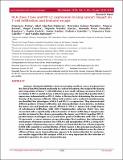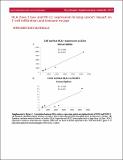Por favor, use este identificador para citar o enlazar a este item:
http://hdl.handle.net/10261/170356COMPARTIR / EXPORTAR:
 SHARE
BASE SHARE
BASE
|
|
| Visualizar otros formatos: MARC | Dublin Core | RDF | ORE | MODS | METS | DIDL | DATACITE | |

| Título: | HLA class I loss and PD-L1 expression in lung cancer: impact on T-cell infiltration and immune escape |
Autor: | Perea, F.; Sánchez-Palencia, Abel; Gómez-Morales, Mercedes; Bernal, Mónica; Concha, Ángel; Méndez García, Míguela; González-Ramírez, Amanda Rocío; Kerick, Martin; Martín, J.; Garrido, Federico; Ruiz-Cabello, Francisco; Aptsiauri, Natalia | Palabras clave: | HLA class I loss Lung cancer Programmed death ligand 1 (PD-L1) Tumor infiltrating lymphocytes (TILs) |
Fecha de publicación: | 19-dic-2017 | Editor: | Impact Journals | Citación: | Oncotarget | Resumen: | Immune-checkpoint inhibitors show encouraging results in cancer treatment, but the clinical benefit is limited exclusively to a subset of patients. We analyzed the density and composition of tumor T-cell infiltration in non-small-cell lung carcinoma (NSCLC) in relation to PD-L1 and HLA class I (HLA-I) expression. We found that positive HLA-I expression, independently on PD-L1 status, is the key factor determining the increased density of the immune infiltrate. When both markers were analyzed simultaneously, we identified four phenotypes of HLA-I and PD-L1 co-expression. They demonstrated different patterns of tumor infiltration and clinicopathologic characteristics, including the tumor size and lymphatic spread. All HLA-I+/PD-L1+ tumors had a high degree of intratumoral infiltration with CD8+T-lymphocytes, whereas HLA-I loss was associated with a significantly reduced number of tumor infiltrating T-lymphocytes mostly restrained in the stroma surrounding the tumor nest. HLA-I-negative/PD-L1-positive tumors had bigger size (T) and lower grade of infiltration with CD8+T-cells. It represents a cancer immune escape phenotype that combines two independent mechanisms of immune evasion: loss of HLA-I and upregulation of PD-L1. Using GCH-array analysis of human lung cancer cell lines we found that the loss of heterozygosity (LOH) with complete or partial deletion of HLA-I genes is the principal mechanism of HLA-I alterations. This irreversible defect, which could potentially decrease the clinical efficacy of lung cancer immunotherapy, appears to be underestimated. In conclusion, our results suggest that the analysis of HLA-I is very important for the selection of potential responders to cancer immunotherapy. | Versión del editor: | http://www.oncotarget.com/index.php?journal=oncotarget&page=article&op=view&path[]=23469&path[]=73925 | URI: | http://hdl.handle.net/10261/170356 | E-ISSN: | 1949-2553 |
| Aparece en las colecciones: | (IPBLN) Artículos |
Ficheros en este ítem:
| Fichero | Descripción | Tamaño | Formato | |
|---|---|---|---|---|
| 23469-330017-4-PB.pdf | Research paper | 2,98 MB | Adobe PDF |  Visualizar/Abrir |
| 23469-330024-1-SP.pdf | Supplementary materials | 368,1 kB | Adobe PDF |  Visualizar/Abrir |
CORE Recommender
Page view(s)
266
checked on 24-abr-2024
Download(s)
335
checked on 24-abr-2024
Google ScholarTM
Check
NOTA: Los ítems de Digital.CSIC están protegidos por copyright, con todos los derechos reservados, a menos que se indique lo contrario.
